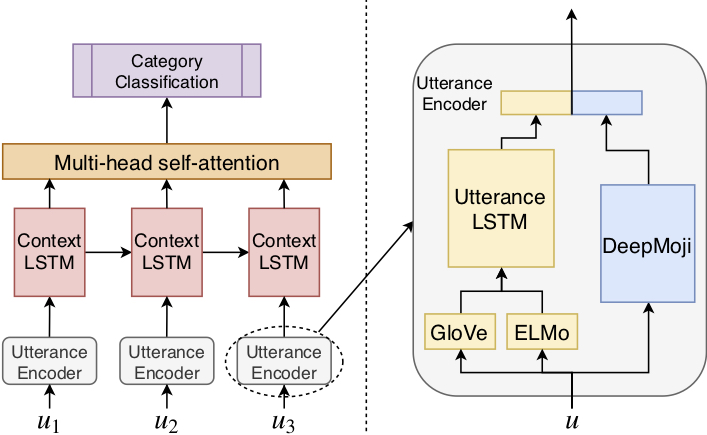News! Our paper is selected as the oral presentation for the SemEval-2019: task 3.
This repo contains the code for our paper,
ANA at SemEval-2019 Task 3: Contextual Emotion detection in Conversations through hierarchical LSTMs and BERT
The paper is in the proceeding of The 13th International Workshop on Semantic Evaluation collocated with NAACL, Minneapolis, USA 2-7 June, 2019.. Please consider cite our paper if you find our work is helpful.
@inproceedings{huang2019ana,
title = "ANA at SemEval-2019 Task 3: Contextual Emotion detection in Conversations through hierarchical LSTMs and BERT",
author = {Huang, Chenyang and
Trabelsi, Amine and
Za\"{i}ane, Osmar},
booktitle = "Proceedings of the 13th International Workshop on Semantic Evaluation",
month = jun,
year = "2019",
address = "Minneapolis, Minnesota, USA",
publisher = "Association for Computational Linguistics",
pages = "49--53"
}
Automated Nursing Agent (ANA) is a project founded by Alberta Machine Intelligence Institute (AMII). For more details, please visit the webpages.
HRLCE is a single model that can achieve a score of 0.7666 on the final test set while only using the training dataset.
We also finetune the BERT-LARGE model on this task. The results of BERT and HRLCE are combined to get the 0.7709 which ranked at 5th on the leaderboard of SemEval 2019 Task3.
You can find the leaderboard from CodaLab.
PyTorch1.0 with Python 3.6 serve as the backbones of this project.
The code is using one GPU by default, you have to modify the code to make it running on CPU or multiple GPUs.
The code includes more features than what has been described in the paper. For example, we experimented with multi-task learning and focal loss, but we found no significant difference.
To run the code, you have to specify the path to the glove.840B.300d.txt model file in -glovepath argument option. Other options are configured with some default value. In our experience, the learning rate and decay would have more impact than others.
You have to download the DeepMoji pretrain model if you haven't used it before. I am using the implementation by Hugginface (https://github.com/huggingface/torchMoji).
To avoid the conficts of some packages, I suggest using the fork from me directly (https://github.com/chenyangh/torchMoji.git). Following the instructions for installation and download the model by the following script (under the direcory of their repo):
git clone https://github.com/chenyangh/torchMoji.git
cd torchMoji
pip install -e .
python scripts/download_weights.py
I can not include it in my repo because it exceeds the size limit of GitHub.
The results are shown in the following table:
| Macro-F1 | Happy | Angry | Sad | Harm. Mean | |
|---|---|---|---|---|---|
| SL | Dev Test |
0.6430 0.6400 |
0.7530 0.7190 |
0.7180 0.7300 |
0.7016 0.6939 |
| SLD | Dev Test |
0.6470 0.6350 |
0.7610 0.7180 |
0.7360 0.7360 |
0.7112 0.6934 |
| HRLCE | Dev Test |
0.7460 0.7220 |
0.7590 0.7660 |
0.8100 0.8180 |
0.7706 0.7666 |
| BERT | Dev Test |
0.7138 0.7151 |
0.7736 0.7654 |
0.8106 0.8157 |
0.7638 0.7631 |
Compared to HRLCE, we notice that BERT performs better on Angry but worse on Happy, therefore it makes sense to combine the results of these two.
Another note, in order to get your submissions measured the same way as that from CodaLab, you will need to look at the harmonic mean of the three macro F1 scores of the three emotion categories. It is slightly different than using the micro F scores of the three emotion categories directly.
HRLCE itself was able to get into the top 10 while only using the train set.
Last but not least: The importance weight of samples is a VERY important factor, for there is an inconsistency between the training data (train set) and the testing data (dev and test sets). We did not emphasis it on our paper (we did not have space left). Please refer to our paper to see how we reweight the training samples.
This code is relying on the work of the following projects:
Many thanks to my supervisor Osmar R. Zaïane for supporting me working on this shared task.


